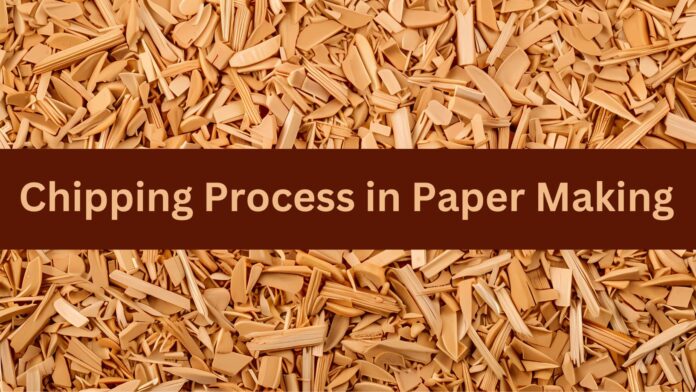The chipping process in paper making is a crucial step in converting raw wood into pulp, which is then used to create paper. This process involves breaking down large logs and other wood materials into smaller, uniform wood chips. These chips are further processed to extract cellulose fibers, the essential component of paper.
Understanding the chipping process is key for industries that rely on efficient and sustainable paper production. This blog will provide an in-depth look into the chipping process, the materials involved, the machinery used, and its advantages and disadvantages. Let’s have a look at the chipping process in paper-making in detail.
What is the Chipping Process in Papermaking?
The chipping process refers to the mechanical conversion of raw wood materials into small, uniform wood chips. This is one of the first steps in the production of wood pulp, the primary material used to manufacture paper. Unlike the recycled paper manufacturing process, chipping is involved in the virgin paper-making process.
In this process, the quality and consistency of the wood chips are critical because they directly affect the efficiency of subsequent processes like pulping and bleaching. The chipping process helps ensure that wood is broken down into the right size and shape to facilitate chemical and mechanical pulping.
Raw Material Used in the Chipping Process
In the chipping process, the primary raw material is wood, usually sourced from softwood and hardwood trees. The choice of wood depends on the type of paper being produced. Softwoods, such as pine and spruce, have long fibers that provide strength and durability to the paper, making them ideal for products like packaging materials. Hardwoods, such as birch and eucalyptus, have shorter fibers, which are typically used for producing smoother and more printable papers, like office paper and tissue products.
Wood can come from various sources:
- Whole Logs: These are debarked and cut into smaller lengths before being chipped.
- Wood Residues: This includes sawdust, shavings, and other by-products from the lumber industry.
- Recycled Wood: Used wood materials are sometimes chipped to be repurposed in paper manufacturing.
Steps Involved in the Chipping Process in Paper Making
The chipping process involves several steps, each essential to preparing the wood for pulping and paper production:
- Debarking: The debarking process is the first step in the chipping process. It is done before the wood can be chipped. The removal of the bark is essential as the bark is often considered a contaminant in the pulping process and can negatively affect the quality of the final product. Debarking is done using mechanical debarking drums or high-pressure water jets.
- Log Cutting: After debarking, the logs are cut into shorter lengths to fit into the chipper. This process ensures the logs are of a uniform size, making them easier to handle and process.
- Chipping: The pre-cut logs are fed into a chipper, where they are sliced into uniform chips. The chipper contains rotating knives that slice the wood into specific sizes. The size and uniformity of the chips are critical for efficient pulping.
- Screening: After chipping, the wood chips are passed through a screening process where oversized or undersized chips are removed. Only chips of the correct size are sent to the pulping process.
- Storage and Transport: The screened wood chips are stored in large silos or bins until they are needed for pulping. They are then transported to the pulping mill, where they will be processed further.
Machinery for Chipping Process in Paper Making
Several types of machinery are used in the chipping process, each designed to perform specific tasks efficiently:
- Debarkers: These machines remove bark from the logs. Drum debarkers are commonly used for large-scale operations, while smaller operations may use ring debarkers or high-pressure water jets.
- Log Cutters: Mechanical log cutters or saws are used to cut logs into shorter, manageable lengths before chipping.
- Chippers: The primary machine in the chipping process is the chipper itself. There are different types of chippers, including disc chippers, drum chippers, and screw chippers. Disc chippers use rotating blades mounted on a large steel disc to slice the wood, while drum chippers use a rotating drum with knives to achieve the same result.
- Screeners: After chipping, wood chips are passed through vibratory screens or rotary screens to separate chips by size. Oversized chips are sent back for further chipping, while undersized particles, known as fines, are either discarded or used as fuel.
- Conveyors: Conveyors are used to transport logs, chips, and other materials throughout the process. They are an essential part of the automation system in modern paper mills.
All the machinery mentioned above is part of the chipping process in wood pulping. For more details and information about other machinery in wood pulping you can contact our team.
Conclusion
The chipping process in paper making is a critical first step in transforming raw wood into paper. From debarking and cutting to chipping and screening, each step ensures that the wood is prepared efficiently for the pulping process. While the machinery used is powerful and efficient, it also requires careful management and maintenance to ensure that the process remains sustainable. By understanding the chipping process, paper manufacturers can optimize their production lines, reduce waste, and contribute to a more sustainable paper industry.

